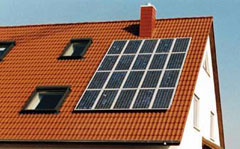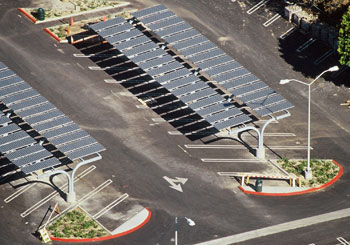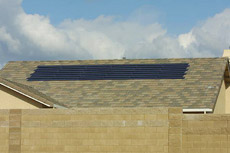Our Solar Future
Air Date: Week of June 25, 2004
The prospect of cheap electricity from the sun has been promised for decades, and has gone largely undelivered. But as Living on Earth’s Ingrid Lobet reports, new technologies are changing the economics of solar power and spurring a multi-billion dollar industry.
Transcript
CURWOOD: It’s Living on Earth. I’m Steve Curwood.
If you press your ear to the door of the solar industry right now, you'll hear a buzz; the sense that something's happening or about to happen. On the other hand, making lots of electricity directly from sunlight has supposedly been "just around the corner" for decades. Always about to take off ---yet solar roofs are still few and far between.
You really think about it when you fly in a plane and look down. There we are under this astral broiler -- it blazes down, soaking into miles of black rooftop, heating up buildings to the point of discomfort. So we switch on the AC, and sometimes overload the power grid as we reverse the sun-made heat. It seems like a huge waste. Many in business agree and they see an opportunity.
As Ingrid Lobet of our West Coast bureau reports, the changing economics of solar power are making it a multi-billion dollar enterprise.
LOBET: From his post as manager of the venture capital firm Nth Power in San Francisco, Tim Woodward’s view is that public perception hasn't kept up with the reality of solar electricity.
WOODWARD: People don't realize that there's three billion dollars of revenue generated in solar. They always believe it's this niche product that you see on highways and buoys in the harbor. And relatively speaking, that's true. I mean, there are not that many houses in the United States that have solar panels on them. But when you total it all up on a global basis, it is a very large number. And that’s what people are starting to understand.
LOBET: Woodward cites $3 billion. The industry's own figure approaches $5 billion. That's about as large as organic agriculture was when it burst on the scene in the late 1990s. And sales of solar are growing at a brisk pace, 30 to 35 percent a year. Woodward says that's making some investors take notice.
WOODWARD: We’re getting a lot more inquiries from institutional sources of money that are reading the tea leaves and saying, "This market is changing. Can we talk to you?”
LOBET: And solar companies are hungry to soak up any capital. They're investing in faster equipment in a fierce effort to drive down the cost of building solar panels. The cost has come down, but power experts say it still needs to drop from about $700 for a 100-watt panel, installed, down to about $300.
WOODWARD: We believe the costs are coming down at a significant enough rate that it will be very economical. Every three years the volume of output of the industry doubles, and for every doubling of output the cost comes down 18 percent.
LOBET: Living on Earth visited several solar businesses and found solar cells practically flying out of warehouses. Demand is high. Stocks are low. Business is good. Today, we'll find out how that's happened and why that hasn't automatically translated into panels on your neighbor's roof.
First, it helps to know a little bit about how solar panels are made. Did you realize they're basically the same silicon as Silicon Valley microchips?
[SOUND OF SILICON ROCKS]
Silicon comes from silica -- sand or quartz. It's the second most abundant element in the earth's crust. In Michigan, Wisconsin and Washington state, factories take raw silica and refine it into what's now called “solar grade” silicon.
LOBET: And from these rocks, they pour or spin silver ingots -- long, squared-off cylinders you could mistake for metal, but, of course, are more like glass.
[SOUND OF SILICON INGOTS]
LOBET: These ingots fill a display case at the Shell Solar factory in southern California. The oil companies BP and Shell are now among the biggest producers of solar power.
[DOOR OPENING INTO ROOM]
LOBET: Next, the long 20-pound silicon ingots are sliced into paper-thin wafers. Shell Solar's Tina Nickerson shows me a stack of discards, like thin CDs.
[WAFER PINGING, BREAKING SOUND, SOUND OF TALKING]
NICKERSON: So, if you press down in the middle...
LOBET: Oh, look at that.
NICKERSON: It breaks into four perfect triangles.
LOBET: To illustrate the crystalline structure that helps silicon wafers convert the sun's photons into electric current, she pushes a ballpoint into the center of one.
|
|
DEYIRMENCIAN: For example, this could have been a clean room. If it was a clean room it would have HEPA-filtered air and so forth and would cost us another $10-15 million to set it up and run it. LOBET: The company also just doubled production by installing robots, including one beefy robot they call Arnold, after the state's solar-friendly governor. [ROBOT SOUND] DEYIRMENCIAN: That's the bottom line: make it cheap enough for anybody to afford it, then everybody will have one on their roof. That will be the ultimate thing to see. So, we are diligently working towards that end. LOBET: And there have been other improvements in solar panels that you may have missed. Operations Director Terry Jester remembers silicon cells used to be round instead of squared. That meant less conductive surface. JESTER: Now, if you look at almost all the panels on the market have more solar cell and less white space because the amount of power generated per square foot or per square meter is becoming critical. LOBET: So, if I looked at a 100-watt panel when you started in the business versus now, what would the size difference be? JESTER: It might 50 percent smaller, from, say, a meter and a half down to a meter now. LOBET: Highway call boxes and mountain radio towers were, for a time, the solar industry's bread and butter. But no more. We're now solidly into the era of grid-connected solar. Increasingly, they're going on to the roofs of Fortune 500 companies, often with the help of an upstart firm out of Berkeley, California. Powerlight Corporation started in a garage 13 years ago. Last year it did $55 million in sales. Standing in his factory, Powerlight President Dan Shugar says one advance that puts solar systems on businesses is that they last longer. SHUGAR: The technology has matured to the point where every major manufacturer now provides a 25-year warranty on the guaranteed power from every single solar panel. We have incentives here in California that pay for about 50 percent of the cost of these systems. And so you know that, hey, after the system's paid off, I still have another two-thirds of the life of the system left or more to recover the value of the asset. LOBET: And in many places, you can now sell what you produce on your rooftop back to the power company. Powerlight’s customers don't merely save the high cost of afternoon electricity; the power they produce at that time is credited against the juice they do use. That's called “net metering.” Shugar used to work at the power company, and he fielded one of the first requests for this idea even before it was called net-metering. SHUGAR: I happened to be working at PG and E and we got a call from a famous actor-comedian who – really, his goal was, he had a large ranch in Northern California and he wanted to generate enough power to essentially net out his bill so he was a zero net energy consumer. We thought that was a great idea at the solar group at the utility. But we couldn't get it through. We were, essentially, blocked by the law department because God forbid an electron could find it's way into the transmission system and cross an interstate boundary. LOBET: Today, 38 states have net metering. It's one more factor contributing to the growth of solar. In response to the demand, it seems like everyone is setting up new production lines: Sharp Electronics in Tennessee and Japan, BP Solar in Australia, Evergreen Solar in Massachusetts, Kyocera in China, Spire Solar in New Mexico. SHUGAR: I just finished a world tour of many of the manufacturing facilities. There's huge investments going in. A lot of manufacturers are doubling their capacity. The global manufacturing capacity has grown from about 20 megawatts in 1988 to 750 megawatts today. LOBET: In fact, some industry watchers are warning of too much capacity as all these new plants come on line. At the moment though, most producers scoff at this. They're sold out. Warehouses are low or empty. That's true even at a high-end shop in Sacramento where Joe Morrissey sells a product called “Sunslates.” MORRISSEY: I just talked to somebody in Spain this morning. And they want three containers sent immediately. LOBET: Shipping containers? MORRISSEY: Shipping containers, 40-foot shipping containers of material. And this is just for Spain. This particular company is going to Amsterdam on Wednesday and Austria and then on to Budapest. LOBET: And that points to another reason you haven't necessarily noticed the current heat in the solar business. The product is going to Europe and Japan. That’s because in Japan, electricity already costs more, and in Europe the government reimburses a large share of homeowners' installation cost. MORRISSEY: The Europeans have just jumped ahead and they said, “Look, this is a real deal here. We want as much green energy as we can get.” And they've really put their money where their mouth is. And it’s just drained the global market. It's all flowing to Europe right now.
|

 The panels on this roof are made of tempered glass that can endure severe weather conditions. They contain multi-crystalline silicon solar cells which harness solar power. (Photo: Shell Solar)
The panels on this roof are made of tempered glass that can endure severe weather conditions. They contain multi-crystalline silicon solar cells which harness solar power. (Photo: Shell Solar)  California State University Northridge has installed 3,000 solar panels in a student parking lot. The panels which also provide shade, produce 75 watts of power each reducing energy costs for the university by more than $50,000. (Photo: Shell Solar)
California State University Northridge has installed 3,000 solar panels in a student parking lot. The panels which also provide shade, produce 75 watts of power each reducing energy costs for the university by more than $50,000. (Photo: Shell Solar)  The Sacramento Municipal Utility District worked with builders and the state to provide building-integrated solar panels that blend into homes in Lincoln, California. (Photo: SMUD)
The Sacramento Municipal Utility District worked with builders and the state to provide building-integrated solar panels that blend into homes in Lincoln, California. (Photo: SMUD) 



